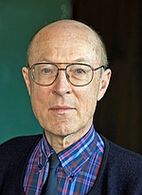
J. Leo van Hemmen
Prof. Dr. habil.
Former Professor for theoretical biophysics
TUM School of Natural Sciences
born 09.05.1947
CV
Professor van Hemmen's field of research is cellular theoretical biphysics, both theoretical membrane physics and neuronal information processing of varius sensory organs. These include in particular mechanosensorics and the associated research on, among other things, the sound location of barn owls, they prey location of desert scorpions, the localisation and neuronal mapping of aquatic objects via the lateral line of clawed frogs and fish, as well as the localisation of snakes during hearing and infrared vision. Another focus is the theory of multimodal integration and its bionic realization, with Prof. van Hemmen, for example, creating the artificial fish 'Snookie'.
Professor van Hemmen studied physics and mathematics at the University of Groningen (NL), where he received his doctorate in 1976. After one year as a postdoctoral fellow at the Institut des Hautes Etudes Scientifiques (IHES) in Bures-sur-Yvette, near Paris, he worked as an assistant professor at Duke University (Durham, NC; USA) for one year, before moving to Heidelberg for the SFB 123 (Stochastic Mathematical Models), where he habilitated in physics in 1983 with his spin glass model. The van-Hemmen model is the only exactly solvable spin-glass model that correctly describes the three-dimensional phase transition with the correct number of ergodic states below the critical temperature and the thermodynamic low-temperature behaviour. The van Hemmen-Ando inequality from the theory of operator algebras also goes back to him. In addition, together with Andras Sütö (Ung. Akad. d. Wiss.) he comprehensively solved the tunneling of quantum spins and developed their WKB description; both terms had previously only been clarified and successfully applied for particles. From 1990 to 2015 Prof. van Hemmen taught cellular theoretical biophysics, especially neuronal information processing, at the Physics Department of the TUM. During this time, the whole range of neuronal information processing was mathematically modeled in detail at his chair on the basis of careful analysis of the biophysics of perception. This was accompanied by the development of several well-known models such as spike-timing-dependent plasticity (STDP), mono- and multimodal object location, and the general theory of map formation based on concrete examples from different animal species. Professor van Hemmen is a second member of the Faculty of Mathematics and a fellow of the American Physical Society.
Short biography
| 1965 - 1976 | Studies in physics mathematics and chemistry and doctorate in theoretical physics, University Gröningen, Netherlands |
| 1976 - 1977 | Visiting Member, Institut des Hautes Etudes Scientifiques, Bures-sur-Yvette, France |
| 1977 - 1978 | Assistant Professor, Duke University, Durham, North Carolina, USA |
| 1978 - 1984 | scientific assistant at SFB 123, University Heidelberg |
| 1983 | Habilitation, University Heidelberg |
| 1984 - 1989 | Private lecturer at SFB 123, University Heidelberg |
| 1990 - 2015 | Professor of theoretical biophysics, TU Munich |
Memberships and honors
Fellow of American Physical Society ( since 1999)
Editor-in-Chief of Biological Cybernetics, Springer-Verlag (2006-2017)
You can download "Explanations of honors and awards" here [PDF 215 KB]
Key publications
van Hemmen JL, Schwartz AB: Population vector code: a geometric universal as actuator. Biol. Cybern. 2008; 98(6): 509-518.
Friedel P, Young BA, van Hemmen JL: Auditory localization of ground-borne vibrations in snakes. Phys. Rev. Lett. 2008; 100(4): 48701/1-4.
Sichert AB, Friedel P, van Hemmen JL: Snake’s perspective on heat: Reconstruction of input using an imperfect detection system. Phys. Rev. Lett. 2006; 97(6): 068105/1-4.
Kempter R, Gerstner W, van Hemmen JL, Hebbian learning and spiking neurons. Phys. Rev. E 1999; 59(4): 4498-4514
Gerstner W, Kempter R, van Hemmen JL, Wagner H: A neuronal learning rule for sub-millisecond temporal coding. Nature 1996; 383: 76-78.